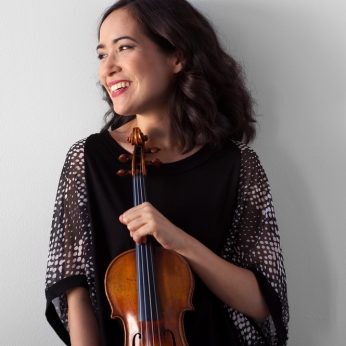Composer: Johannes Brahms (b. 1833 - d. 1897)
Performance date: 02/07/2023
Venue: Bantry House
Composition Year: 1865
Duration: 00:39:39
Recording Engineer: Tom Norton, RTÉ
Instrumentation: 2vn, 2va, 2vc
Instrumentation Category:String Sextet
Artists:
Viviane Hagner -
[violin]
Mairead Hickey -
[violin]
Emma Wernig -
[Viola]
Seamus Hickey -
[viola]
Claudio Bohórquez -
[Cello]
Christopher Marwood -
[cello]

String Sextet No 2 in G major Op.36 [1864-5]
Brahms’ love life is spelt out in his music for all to hear. In 1858 he had met and fallen for a young singer, Agathe von Siebold, who had a haunting voice like an Amati violin. She was also lively and intelligent and his own age, unlike Clara Schumann, who was 14 years older than him. Clara was of course his first love, but they had already decided that marriage was impossible. Indeed she often urged him to find himself a nice young wife, but actually seeing him with his arm around Agathe was too much for her. Brahms got as far as secretly exchanging rings with Agathe, but his nerve failed him and he brutally broke off the engagement in 1859 and they never saw each other again. The story reappears in his Magelone-Lieder and Rinaldo and, dramatically, in the G major Sextet. His distress at this time was compounded by the total failure of his D minor Piano Concerto at the Leipzig Gewandhaus, where he was hissed off the stage.
The Sextet has a richness of sonority matched only by the B flat Sextet and these two works stand out like beacons amongst the comparatively small repertoire for this luscious combination of instruments. Brahms may have seen the six strings as an ensemble with a less awe-inspiring history than the string quartet. He claimed to have destroyed at least 20 string quartets before he finally published his first two in 1873.
The opening of the G major Sextet is extraordinary and immediately shows the black areas of harmonic instability that Brahms is prepared to exploit before launching into his big themes. The semitone oscillation across two strings of the first viola that opens the work is present in many forms throughout the exposition either in the foreground as at the beginning or muttering away backstage. After the exposition repeat it becomes the obsessive subject of the development, which concentrates on this searching in the dark rather than either of the big themes. The first and second subjects both spawn glorious tunes, especially the second, which quotes the AGADHE code at the climactic moment. You cannot help wondering what Clara’s comments were.
In the Scherzo Brahms reworks an idea from a neo-Baroque Gavotte that he penned in 1854, which retains both its minor key and its stylized dance character. It gets in addition a rhythmic irregularity, which adds to the mood of uncertainty already created by the first movement. The Trio however makes up for this with a rumbustious Presto giocoso with a strong Bohemian flavour. The transition back to the Scherzo is very cleverly manipulated so you hardly notice the moment of change. The coda is a sudden furious outburst.
The Adagio is a set of variations in E minor based on a theme given by the first violin accompanied by only violin and viola that recalls the feeling of loss of the opening of the first movement and bears the same Baroque tinge that we found in the Scherzo. Brahms was of course a music scholar of immense erudition, who studied early music from manuscript sources. The theme, which is very short, leads without a break into the romantic sighing and pizzicato cello of the first variation. The next variation led by the cellos also follows without interrupting the flow, the mood now pensive and questioning. Still in the minor key the fugal third variation takes a more strenuous approach evoking thoughts among cellists of the E minor Sonata that was being written at the same time. The fourth develops the subject at a livelier tempo before a smooth and deliciously anticipatory transition to, at long last, the major key. This is summer nights music, Brahms has exorcised his lost love and reached a moment of pure tranquillity. The E major key is held for the coda and the movement closes in peace.
The opening idea of the Finale recalls that persistent oscillating figure of the first movement but this time it is an element of stability giving the movement its energy. The second half of this group is a warm and vibrant tune that reflects the newly won contentment. Gradually the music takes on the character of a majestic and eternal dance seemingly unconcerned with the impossible vagaries of human emotions. But the dance cannot go on forever and the coda tries the usual trick of accelerating into the finish, this fails so he tries the opposite, slowing down until the music stops, which also fails, then he recalls the roundelay theme and now the accelerando drives to the finish.
Francis Humphrys
Copyright © 2025 West Cork Music. All rights reserved.
Designed and developed by Matrix Internet